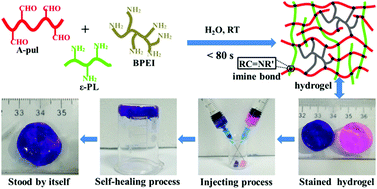Multiresponsive and biocompatible self-healing hydrogel: its facile synthesis in water, characterization and properties
Abstract
Multiresponsive and biocompatible self-healing ε-PL/A-Pul/BPEI hydrogels were prepared in aqueous solution by Schiff base reaction with aldehyded pullulan (A-Pul), ε-poly-L-lysine (ε-PL) and branched polyethyleneimine (BPEI) as materials. The imine bonds were rapidly cross-linked into a hydrogel network within 80 s. Scanning electron microscopy images showed that the hydrogels exhibited a cross-linked structure with the average pore size from 58 to 82 μm. Rheology tests indicated that the hydrogels maintained good mechanical properties. Water contact angles and swelling studies suggested that the hydrogels could swell in water, with a max swell ratio of 1559%, and pH and temperature had an influence on the equilibrium swelling ratio. The hydrogels could be injected either before or after gelation, and they displayed a self-healing process in ddH2O at room temperature based on the dynamic uncoupling and recoupling of the imine bonds. The MTT assays implied that the hydrogels were non-cytotoxic on mice bone marrow mesenchymal stem cells. Therefore, the hydrogels showed potential application in biomedical fields, and consequently further work was performed using the self-healing hydrogels as drug carriers in in vitro/vivo antitumor studies.



 Please wait while we load your content...
Please wait while we load your content...